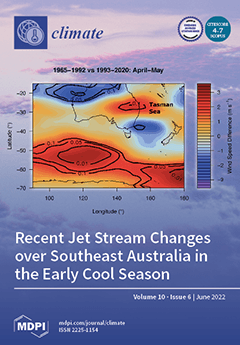The increase in the intensity and frequency of climate extremes threatens socioeconomic development. This study examines variability of mean and extreme climate, farmers’ perception of the changes, and impacts in the Awash River Basin. Daily rainfall and temperature data were used to analyze
[...] Read more.
The increase in the intensity and frequency of climate extremes threatens socioeconomic development. This study examines variability of mean and extreme climate, farmers’ perception of the changes, and impacts in the Awash River Basin. Daily rainfall and temperature data were used to analyze 23 extreme climate indices. The Mann–Kendall test was used to assess the magnitude and significance of the changes. Results show an increase in minimum (0.019–0.055 °C/year) and maximum temperatures (0.049–0.09 °C/year), while total rainfall is on a downward trend (from −3.84 mm/year to −10.26 mm/year). Warm extreme temperature indicators, including warmest day (TXx), warmest night (TNx), warm day (TX90p), warm night (TN90p), and warm spell duration indicator (WSDI), show a significant increasing trend (
p < 0.05). Nevertheless, except the tepid–cool humid agroecology zone, cold extreme temperature indicators in cool days (TN10p), cool nights (TX10p), and cold spell duration (CSDI) are declining. Extreme precipitation indices, including maximum 1-day precipitation amount (RX1day), count of days when precipitation ≥10 mm (R10 mm), maximum 5-day precipitation amount (RX5day), count of days when precipitation ≥20 mm (R20mm), very wet days (R95p), extreme wet days (R99p), and total precipitation (PRCPTOT), show a decreasing trend. The perception of most farmers’ on climate change and climate extremes agreed with climate records. The major impacts perceived and asserted over all agroecologies are food price inflation, crop productivity decline, crop pests and diseases spread, livestock disease increase, and the emergence of pests and weeds. The increasing trend in extreme warm temperatures, decreasing trend in the cold extreme, and declining trend in precipitation indicators affected agricultural productivity and farmers whose livelihood depends on rainfed agriculture. This agroecology-specific study provides critical information to policymakers, decision makers, and farmers about the potential impacts of climate change and extreme events, leading to the development of agroecology-based adaptation measures.
Full article





